
July 2023
By: Josh Walejewski
Read Time: 4-5 Minutes
Whether you’re currently in the market for a new home or have recently become a homeowner, moving into a new home can be an exciting yet overwhelming experience. Amidst the countless factors to consider, one aspect often overlooked is the HVAC system. But fear not! Our goal with this month’s blog is to equip you with the knowledge to understand what to look for in a home’s HVAC system.
The most important factors to know about a home’s HVAC system are the age of the system, the type of system, the system’s fuel/energy source, and the system’s service history. So, let’s dive in and explore each consideration to help you get the most out of your investment.
How old is the home’s HVAC system?
The age of a home’s HVAC system is the most important aspect to consider. The average life expectancy of a standard furnace and AC system is 15-20 years. Knowing the age of the HVAC system of a home will give you an idea of how much life it has left.
Why is this important? Well, a new HVAC system may cost $10,000 or more depending on the size of the home and the type of system that needs to be installed. An older heating and cooling system may be out of warranty, will be more prone to needing repairs, and have higher operating costs compared to a newer, more efficient system. They say ‘ignorance is bliss’, but I can guarantee you won’t be feeling blissful if your HVAC system fails during the hottest or coldest time of the year. Knowing the age of your system will help you to proactively plan and budget for its replacement.
What type of HVAC system is currently in the home?
There are many different types of heating and cooling systems. The most common HVAC system is a forced air system, but other types of systems commonly found in Wisconsin homes include boilers, ductless mini-splits, heat pumps, and electric baseboard heating.
Let’s go over each type of system and visual clues to look for that will help you identify what type of system a home has.
Forced Air Systems
Forced air systems typically consist of a furnace and a central air conditioning system. A forced air system works by using a central unit to heat or cool air, which is then moved through ductwork and distributed to different areas of the home.
The easiest way to identify a forced air system is to look for ductwork and vents in the home. If the home’s basement isn’t finished, you can usually see exposed ductwork in the basement.
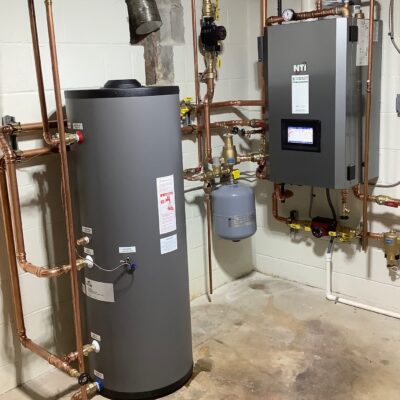
Boilers/Radiant Heat
A residential boiler system is a heating system that uses water or steam to distribute warmth throughout a home. The system typically consists of a boiler, pipes, and radiators. The boiler heats the water or generates steam, which is then circulated through the pipes to the radiators, releasing radiant heat into the rooms. These systems typically last longer than other types of systems but come with a higher cost if a replacement is needed.
Any guesses on how to identify a home that uses a boiler/radiant heating system? You got it! No ductwork! However, some homes with a boiler system may still have ductwork for cooling. In these situations, the home likely has an air-handling unit and ductwork which is tucked away in the attic. If you see vents or diffusers on the ceiling and don’t see any near the floors, it’s a safe bet the home has a central air conditioning unit and boiler/radiant heating system.
Heat Pumps
A heat pump is an electric heating and cooling system that can condition homes more efficiently than traditional heating and cooling systems. Rather than generating heat as a furnace would, heat pumps simply move heat from one location to another. While heating your home, heat pumps extract heat energy from outdoor air and transfer it inside. When cooling, the technology works much like an air conditioner and removes heat energy from inside your home, expelling it outside.
The outdoor component of a heat pump system looks almost identical to an air conditioner’s outdoor unit. Therefore, it’s not easy to visually distinguish a heat pump from an air conditioner. It’s best to ask the seller for more information.

Ductless Mini Splits
A ductless mini-split system is a type of heating and/or cooling system that operates without the need for ductwork. It consists of an outdoor unit and one or more indoor units. The easiest way to identify if a home has a ductless mini split is to look for indoor head units which are usually mounted on walls or ceilings.
Many ductless mini-splits utilize heat pump technology to provide extremely efficient heating and cooling. However, homes that have a boiler system or electric baseboard heating often use a ductless mini-split system for cooling only.

Electric Baseboard
Electric baseboard heating uses electric resistance heating elements installed along the baseboards of a home. While some boiler systems may have similar units installed along the baseboards of walls, an easy way to tell if the home uses electric baseboard heating is if each room has its own thermostat.
Electric baseboard heating is known for its simplicity and quiet operation; however, these systems have extremely high operating costs. If you are interested in a home with electric baseboard heating, be aware that heating costs during the winter months will be much higher compared to other types of heating systems.
How to determine an HVAC system’s fuel source
The most common fuel source for HVAC systems is natural gas, propane, and oil. Different fuel types come with different operating costs. Here are a few ways to identify a home’s heating fuel source and the pros and cons of each.
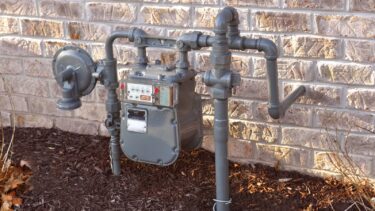 Natural Gas Furnaces
Natural Gas Furnaces
Natural gas is the most common fuel used for residential heating. While the costs of natural gas are rising, it remains one of the most cost-effective fuels for heating. The easiest way to visually determine if a home uses natural gas is to look for a gas meter on the outside of the home.
Pros
- Cheapest fuel available
- Burns clean
- Smaller footprint as no tank is required for fuel storage
Cons
- Not available in every area
- While one of the cleanest fossil fuels, it still creates carbon emissions
Propane Furnaces
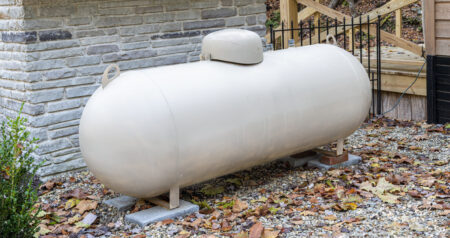 If you see a large, white, round container outside of a home, it’s likely the home relies on propane as a heating fuel. Propane functions much like natural gas but it costs much more. Propane is often used in rural areas where natural gas might not be available.
If you see a large, white, round container outside of a home, it’s likely the home relies on propane as a heating fuel. Propane functions much like natural gas but it costs much more. Propane is often used in rural areas where natural gas might not be available.
Pros
- Cheaper than electric baseboard heat
- Good option for rural areas
Cons
- Higher costs than natural gas
- Tank needs to be replenished once a year or more
- Must have a holding tank on the property that takes up additional space
- Price volatility
Oil Furnaces
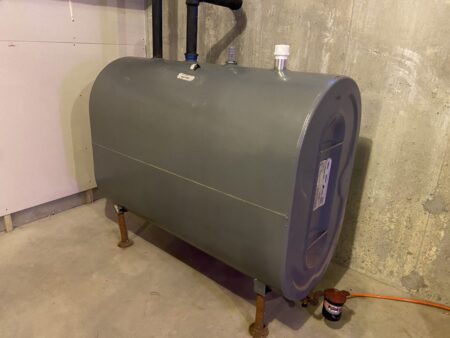 Like propane, oil-burning systems are also commonly found in rural areas where natural gas utilities may not be available. The easiest way to know if a home uses oil as a heating fuel is to check if there is a large tank located in the basement.
Like propane, oil-burning systems are also commonly found in rural areas where natural gas utilities may not be available. The easiest way to know if a home uses oil as a heating fuel is to check if there is a large tank located in the basement.
Pros
- Oil burns hot and produces warmer air out of your vents/registers
- Cheaper than electric baseboard heat
- Good option in rural areas where natural gas may not be available
- Oil-burning systems typically have a longer lifespan than gas equipment
Cons
- High costs and volatility
- Needs to be refilled once or more per year
- Produces odor from burning
- More soot produced, not as clean as natural gas or propane
- Less environmentally friendly
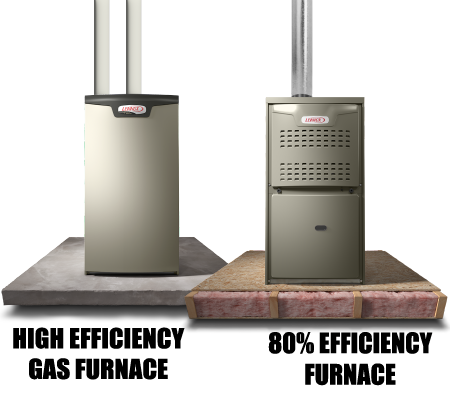
How to identify if a home’s HVAC system is high efficiency
High-efficiency heating systems can reach efficiency ratings up to 99%, offering reduced energy costs. The easiest way to tell if a home has a high-efficiency heating system is to look for two PVC pipes coming off the heating unit. One PVC pipe serves as an intake, while the other PVC pipe is for exhaust. You can also see these same PVC pipes on the outside of the home.
If instead, the heating system has a tin duct coming off the heating unit which vents out the chimney flue naturally. These units, often referred to as “80 percenters”, are only capable of reaching a maximum efficiency rating or Annual Fuel Utilization Efficiency (AFUE) of 80%. Therefore, these systems will have higher operating costs compared to high-efficiency systems.
Review the HVAC system’s service history
Every unit installed by a certified professional should have a service record sticker that will give you an idea of when the unit was installed and how well the unit has been taken care of. A good indicator of a neglected unit will be a service record sticker that is mostly empty.
A neglected unit may have a decreased lifespan and an increased likelihood of needing repairs. A good maintenance record means the warranty coverage will still be in good standing if it hasn’t expired. It’s also wise to take note of the companies who have provided service or installed the system. Are they reputable companies that are still in business? Did the seller use the same company over the years or a different company each time? Reviewing the system’s service history will give you a good idea of what you are getting into.
Wrapping Up
In conclusion, your HVAC system plays a crucial role in your home’s comfort and energy efficiency. Whether you’re in the market for a new home or evaluating your current system, taking the time to assess the age, type, fuel source, and service history of the HVAC system is essential. Understanding the potential lifespan, efficiency, and operating costs will enable you to make informed decisions and plan for future replacements or repairs. By considering these factors, you can ensure a comfortable and cost-effective environment in your new home or optimize the performance of your existing HVAC system.
Read more blog posts from Kettle Moraine Heating & AC.
About the Author
Josh Walejewski
Josh is a professional marketer who has worked in the HVAC industry since 2017. With a Bachelor of Applied Arts and Sciences Degree (B.A.A.S) in marketing and sustainable business management from the University of Wisconsin, he has a passion for all aspects of HVAC, business, marketing, and environmental stewardship.





